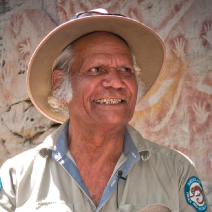I grew up in the mission at Woorabinda, where we were distracted from thinking about our culture with lots of activities, from dancing to rodeo to boxing. By my early teens the superintendent let some slack in the rope though, and we were allowed out on weekends to train in bushtucker and hunt down a roo or porcupine to feed the community. I wanted to be a carpenter so I could build a proper home for my grandparents, but you followed your father into work in those days and he was a stockman.
I didn’t like working on cattle properties at first but it made me respect the countryside. After running away a couple of times, I got a taste for freedom and joined a boxing troupe travelling round Queensland and New South Wales.
When I returned home at the age of 18 I met members of my father’s family who I hadn’t known and started to settle down, fell in love, had children. Having my own children made me want to get back on to country so I could answer their questions about their ancestry.
I was working as a police liaison officer when I met Bernie Singleton, an Aboriginal relics ranger locating and recording things like scarred trees and sacred sites. He asked if I’d be interested in similar work and I said ‘Bloody oath I am’. I was quite a dunce back then, hard of learning, but I had experience of travel and working out bush so I got the job. After working in Brisbane, Rockhampton and Mount Isa, often meeting with the local indigenous people to exchange knowledge, I found myself in Injune in the late 1980s when our funding got cut. Fortunately, I was offered the opportunity to continue in a new role at Carnarvon National Park. I’ve been there, on and off, for the past 30 years.
The first time I saw the Art Gallery in Carnarvon Gorge, as for anyone from my community, it was an eye opener. As I considered the significance of the images the words of my mother’s brother came flooding back to me – he had tried to teach me about the gorge in language when I was a kid. I didn’t know what to expect as an interpretative ranger at first, but visitors just started asking me questions and we got a conversation going. I’m there to make sure people aren’t defacing rock art or stealing plants and instead they start following me on my rounds, sometimes I feel like the pied piper. Graffiti has been a problem in the gorge since the 1920s but being present in uniform, and on the radio, makes offenders think twice.
To see what my ancestors captured on the walls of the gorge gives me great pride. They would mix ochre with water and goanna fat, the most penetrating kind of fat, to paint into the absorbent sandstone. To have captured our dreamtime this way around 2,500 years ago with a bark paintbrush or by freehand drawing is the greatest achievement of all, especially when compared with today’s blink-and-you-miss culture of iPhone photos. Carnarvon was a birthing and burial site so some of the drawings tell where loved ones were buried, though the remains were removed for scientific testing many years ago. The Bidgera people, my people, believe the rainbow serpent (mundah garrah) created the gorge for us and protects the permanency of waters. When I meet young people who have barely been beyond the shopping centre, I see they’re lost. I started mentoring young Bidgera and Karngbal people some years ago and before we head out bush I tell them to put their packed lunches and water bottles back in the fridge. I get them thinking about how they could survive in the bush and pass on the things my grandparents and uncle taught me. Often, about five months after they’ve visited, I’ll get a message saying ‘thank-you, I remembered what this or that plant is, you helped me know my culture’. The bush is one of the best educational places there is, and I’m going to keep drumming that into my own grandchildren.
I officially retired in April and just turned 70, but I’m not finished with the gorge. I live in Duaringa so it’s not hard to get back and I’ll return whenever I’m called upon. Bernice Sigley, the ranger in charge when I started at Carnarvon, is the lady who inspired it all. I was named an honorary protector under the Nature Conservation Act earlier this year, so when I was called to Brisbane in June I thought that was the reason. When I saw Bernice in the audience and she explained I was one of five people to be named a Queensland Great, I was dumfounded. To come from Woorabinda and achieve what I have, I feel like it’s for the whole community, and for all the people that have visited the park and asked me questions over the years. Every visitor to the gorge makes me a proud man, knowing that the little bit of knowledge I have of my culture isn’t going to be lost.


